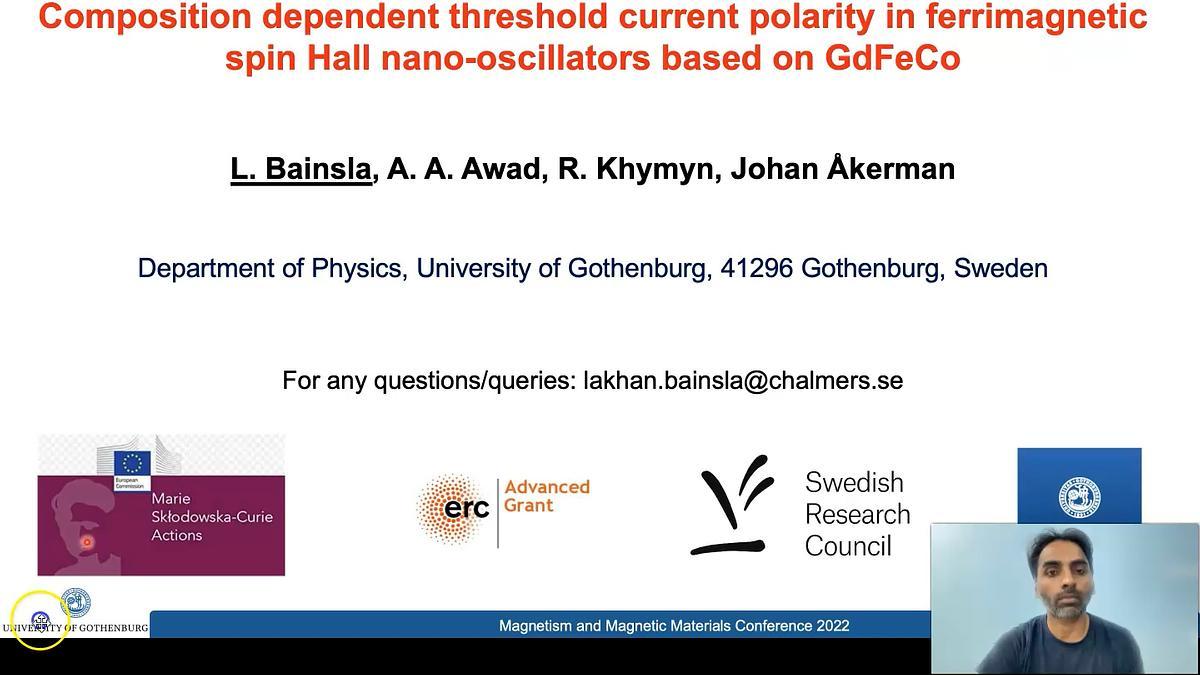
Premium content
Access to this content requires a subscription. You must be a premium user to view this content.

technical paper
Composition dependent threshold current polarity in ferrimagnetic spin Hall nano oscillators based on GdFeCo
Due to their high spin polarization and easy manipulation, ferromagnetic materials dominate as the magnetically active element in spintronic devices but come with drawbacks such as large stray fields, limited scalability, and limited operational frequencies 1-3. These shortcomings have recently inspired researchers to consider antiferromagnetic spintronics 4, as antiferromagnetic materials have no stray fields and possess ultrafast spin dynamics. However, antiferromagnets have no net magnetic moment, which leads to weak read-out signals and more difficult operation. Compensated ferrimagnets (FiMs) provide an alternative as they combine the properties of ferromagnets and antiferromagnets. In particular, FiMs can have near THz resonances as in antiferromagnets, while still having a net magnetic moment which can be used for strong read-out signals and frequency control, such as efficient tunable microwave signal output from FiM based nano-oscillators. Due to these unique properties, research in FiMs for spintronic applications is intensifying 5-7. However, to use ferrimagnets in spintronic devices such as in spin Hall nano-oscillators (SHNOs), it is important to ensure that such films retain their advantageous properties in ultrathin films and in nano devices.
In the present study, ferrimagnetic GdFeCo thin films were grown using co-sputtering of Gd and Fe87.5Co12.5 on high resistance Si (100) substrates, and their magnetodynamic properties were studied using broadband ferromagnetic resonance measurements at room temperature. By tuning the stoichiometry of the GdFeCo films, a nearly compensated behavior is for the first time demonstrated in 2 nm thin film, as shown in Fig. 1. Values for the effective magnetization and effective Gilbert damping constant (α) of 0.02 Tesla and 0.0078±0.0002 are obtained for a 2 nm Gd24.4(FeCo)75.6 film 8, where α is comparable to the lowest value obtained in thick films 9. The vertical dotted lines in Fig. 1 show literature values 6, 9-10 for the spin angular momentum (xa) and magnetic momentum (xm) compensation points in thick films. The composition of the films for the magnetic moment and angular momentum compensation in this work is very close to those reported in the literature.
In search of high-frequency auto-oscillations in spin Hall nano-oscillators (SHNOs), constrictions with 50-300 nm widths were also prepared using GdFeCo(2-10nm)/Pt(5nm) based stacks. Brillouing Light Scattering microscopy measurements on SHNOs show auto-oscillations in the 8 GHz range, as shown in Fig. 2 11. Very interestingly, different Gd compositions result in different signs of the threshold current, which indicates different signs of the effective spin-orbit torque as a function of the composition.

Fig. 2. (a,b) Brillouin Light Scattering Spectroscopy (BLS) vs. current of two GdFeCo based SHNOs with different Gd content, believed to operate at opposite sides of the angular momentum conpensation point (SHNO temperature > RT due to Joule heating). While thermal SWs ferromagnetic resonace (FMR) are seen at all currents, the Gd rich SHNO only shows auto-oscillations (AO) at negative current, and the Gd poor SHNO only shows AO at positive current. (c,d) Log plots of the BLS counts from (a,b) for the thermal spin waves SWs (green) and the AO SWs (red). While the FMR show a slight current dependence due to heating, the AO intensity shows an initially exponential increase, as expected around threshold. Insets shows the BLS spectrum profile at the highest current.
References:
1 M. Romera et al., Nature 2018, 563, 230.
2 M. Zahedinejad et al., Nat. Nanotechnol. 15, 47 (2020).
3 B. Dieny et al., Nat. Elec. 3, 446 (2020).
4 T. Jungwirth et al., Nat. Nanotechnol. 11, 231 (2016).
5 S. K. Kim et al., Nat. Mat. 21, 24 (2022).
6 C. Stanciu et al., Phys. Rev. B 73, 220402 (2006).
7 D. Cespedes-Berrocal et al., Adv. Mat. 33, 2007047 (2021).
8 Lakhan Bainsla et al., Adv. Funct. Mater. 32, 2111693 (2022).
9 D.H. Kim et al., Phys. Rev. L 122, 127203 (2019).
10 Y. Hirata et al., Phys. Rev. B 97, 220403 (R) (2018).
11 L. Bainsla, A. A. Awad, J. Åkerman et al., unpublished.

